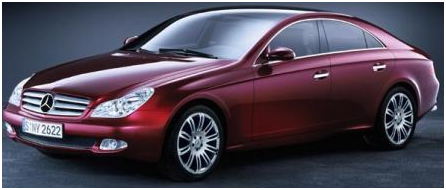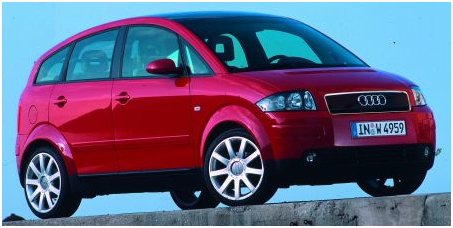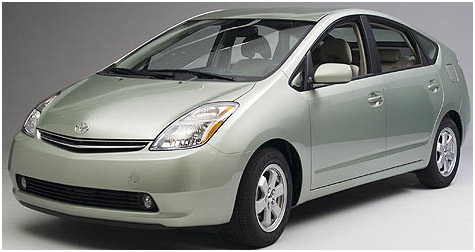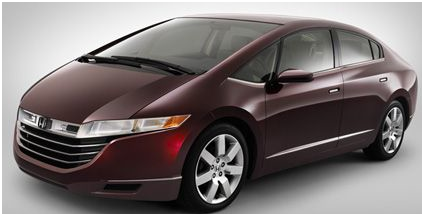ever wonder exactly how modern marketing came to be? check out this marketing history infographic by flowtown.com based on some research that illustrates the history of marketing from the stone age to today in a nice graph.
the ten cars of the decade.
9 JanWith the decade of the 00s concluding it’s time to look back at what happened in the world of automotive. In general, the 00s is considered a decade that most would rather forget, but nevertheless there were some interesting happenings in the automotive industry. As a connoisseur of European cars, with a heavy emphasis on German, my focus was on European cars.
It is too expensive and too small, but that’s intentional: The new edition of the Mini from 2001, was intended as a lifestyle racer, and suddenly driving a small car was chic. Many other manufacturers adopted the idea of offering small-car buyers good design – the first serious attack on the Mini, will follow in 2010 when the Audi A1 comes to the market in Germany.
Up until 2002 Porsche was a pure sports car manufacturer, but then the big boss Wendelin Wiedeking wanted more. He saw that he could exploit the boom for SUVs in the USA for Porsche, so he brought the new Cayenne to the market. The monstrous car brought in so much money for Porsche that they wanted to swallow the much larger VW group. In the climate change / global warming debate, Porsche didn’t look so well with the Cayenne – so a small cylinder and a diesel engine was offered.
In 2001 BMW had to endure scorn and ridicule during the presentation of its new flagship car. Reason was the plump design of the 7 Series with a trunk lid that looked like it was put on after the design was finished. Chief designer Chris Bangle, however, described his work as visionary. In fact, there are some ideas by Bangles used on the 7 Series that can now be found on vehicles of the competition. The same applies to the then criticized “iDrive” knob operation. The newly released 2009 7 Series is again more conservative, but many experts say the Bangle designed 7 Series revived BMW. Toward the end of the 20th Century, car design seemed “perfect”, but also exhausted.
Ford had just taken over Jaguar when Mercedes said: The English competition is coming with a renewed vigor, we need to put up something against it. Out of this basic idea in 2004 the CLS was created – a car that has already secured its place in the history of design. The CLS is a four-door coupe, which is a oxymoron and contradiction for sure. Meanwhile, Audi, BMW, VW, Porsche and Aston Martin also use the sloping roof design in some models. Jaguar as well, naturally.
It costs approx. $2,160 and is intended to be for the Indian market, what was the VW Beetle was in Germany: the start of mobility for all. In Europe, the announcement in 2008 already produced unrest among the established vehicle manufacturers. But before Tata comes to Europe or the United States it will take years. Until then the Dacia Logan at $10,000 will remain the cheapest car in Europe and the Chevy Aveo at $10,895 in the United States.
It would take a downpayment of almost 1,000 Tata Nano, if you want to buy a Bugatti Veyron. According to the will of the former VW chief Ferdinand Piëch in 2005, the 1001-horsepower supercar should be the tip of what is technically possible to achieve: 253 mph top speed, 16 cylinder, 2.5 seconds for zero to 60 mph, $1.55 million. Meanwhile, there is also a roadster for $2.40 million. However, the sales of the car are so low that it will never contribute to the profit of the VW Group.
AUDI A2
Being a car with a full Aluminum body made it very difficult for the Audi A2 from the beginning in 2000. Thus, the small car was only given a very short life span. Although in its most frugal version it got a whopping 78.4 MPG, it was so expensive that it was discontinued in 2005. Three years later, with the climate change debate in full swing, those responsible must have been upset about this decision.
It’s true that it’s career began in 1997 – but at that time, the first large-scale hybrid car in the world was still an ugly duckling and was widely ridiculed. It’s breakthrough came in the second generation of the Prius from 2003, when Hollywood celebrities began to appear with the now trendy Prius. Meanwhile, more than one million Prius have been sold worldwide, and now the German manufacturers are following with hybrid models – however, only in the upper class.
Due to the withdrawal of BMW in the development of hydrogen cars, cars with fuel cells could suffer a setback: This power plant that generates electricity for the on-board electric motor, needs to refuel with hydrogen. Whether the fuel cell will ever be mass produced is open. If this happens, the Honda FCX will be a very special classic car – one for which there is no fuel.
With the end of the decade, the end of the era of the combustion engine could be upon us. If the transition looks like a ride in the Tesla Roadster, no car fan could have anything against it. Since 2008, the sports car with its nearly 7,000 laptop batteries has moved the image of electric vehicles away from that of golf-carts and limitation-mobiles because it is not only clean but also chic and fast. A top speed of 125 mph, zero to 60 mph in 3.7The extremely high price (just under $110,000) is the only real downer. But an up and coming classic does not necessarily have to be perfect. It is sufficient if it points the way to the future.
B2B vs. B2C Marketing: Differences in Social Media Initiatives
4 DecVery telling statistics realeased by eMarketer this morning for B2B & B2C Socail Media usage:
Not only are B2B firms more likely overall to maintain a social network profile, they are managing profiles across more social networks and are significantly more likely to be present on Twitter, LinkedIn and YouTube. On the other side, B2C companies are more likely to maintain Facebook and MySpace profiles.
B2B social media users are more active in measuring most social success metrics. Although B2C companies are more likely than B2B firms to use revenues to measure their efforts, more B2Bs are looking at Web traffic, brand awareness, and prospect lead quality and volume. Web traffic was the top metric for both types of company.
Ver interesting is that 60% of B2B respondents used the online marketing best practice of Twitter search to monitor mentions of their company or brand, but only 35% of B2C companies dis this.
Shoppers use Smartphones to Study, Find, and Buy
1 Dec
By Colby E. Ware for USA TODAY
Mobile phones are now commonplace anywhere: the office, the home, in the car, and of course while shopping. With the increased capabilities that Smartphones offer it’s only natural that they are now doing the heavy-lifting for shoppers when it comes to doing their homework. Phones help shoppers find coupons, store locations and even discover nearby restaurants.
2009 will go down as the first holiday season that retailers are (finally) trying to capitalize on the still niche, but quickly expanding, market of mobile shoppers.
According to a Deloitte survey, about 20% of Americans will use their mobile devices for shopping during the 2009 holiday season. As is to be expected, the percentage is twice as high for young consumers (18-29). Young Shoppers say they’ll use their phones to find store locations, receive coupons and information for sales and to research products and prices.
Now for the most exciting statistic: One-quarter of all who plan to use their phones to shop say they will make purchases on the devices.
Given, the mobile shopping market is still relatively small, even if the sales numbers look impressive at $750 million. But looking at the bigger picture this represents about half of 1% of all online sales.
The trade publication Internet Retailer reported month that 112 retailers have “m-commerce” sites or apps.
Here are a few big boys joining the fun: Toys R Us, Walgreens, American Eagle, Best Buy and Victoria’s Secret recently added mobile sites. Sears and Kmart were one of the first major U.S. retailers to offer a mobile site, last year.
THE ANTI-BLACK FRIDAY
Given the crazies out on Black Friday, the ability to use a mobile device from your couch, bed or kitchen to do price comparisons, check product availability and simply look for other bargains can be invaluable.
How Black Friday Works: Stores offer “door-buster” deals to entice people to come in, knowing they’ll buy more once inside the store. Many such discounts are advertised in advance, letting shoppers do price comparisons from home. But many deals aren’t promoted ahead of time, and other products that aren’t deals are strategically placed around stores.
Here’s where the Smartphone comes in: Consumers now browse the Web from the sales floor for product and price comparisons can save time and money. According to Nita Rollins, a futurist with the digital marketing agency Resource Interactive, “the majority of American consumers will be mobile device-centric in a few years. Now that it’s technologically feasible, possessing such power literally in the palm of our hands is quite irresistible.”
M-COMMERCE EXAMPLES
- Best Buy has had a mobile site since June 2009, however it did not became fully functioning for purchases until the end of September. Michele Azar, Best Buy’s vice president of emerging channels, says even though the retailer thought it important for customers to be able to buy easily on their devices, she says that wasn’t the driving force behind the move to mobile.
- Toys R Us added a mobile site right before the Black Friday craziness. Greg Ahearn, senior vice president of marketing and e-commerce, says it’s designed so consumers can quickly find stores, get “mom ratings” and product descriptions, and make purchases.
“Mobile technology use is growing among all age ranges,” says Ahearn. ” Some youngsters have their own phones and are looking things up, showing them to Mom and Dad and putting the items on their holiday wish lists.”
- EBay’s mobile website attracts 1 million visitors a day. They expects its mobile commerce – which includes a new iPhone deals app – to quadruple in 2010, and says it will have $500 million in revenue in 2009.
“It’s quite possible more people this year will use mobile commerce through eBay and avoid the stores altogether,” says Steve Yankovich, eBay’s vice president of business solutions and mobile.
USING MOBILE TO HELP TEENS AND MOMS SHOP
According to a Resource Interactive study mothers remain the “chief purchasing officers,” and children are the “chief influencing officers.” Teens are using the Internet and their mobile devices influence the brands and products their families bought.
A Mom’s perspective after conducting a purchase via a Smartphone: “I still have much greater comfort level with my PC, but if I came to find (buying) was quick and efficient on my phone, I most definitely would do that – I’m on the road a lot.”
To facilitate the way young shoppers use their phones as tools of influence, Resource Interactive developed a prototype app that would allow teens to e-mail their parents photos from retail websites and get theirs and others’ opinions. If the parents approved, at the click of a button they could authorize the teens to buy the product using an alternative payment site such as BillMyParents.com.
THE FUTURE OF MOBILE COMMERCE?
Facebook Uncool for 18-24s? All of this has happened before
16 Nov
To steal a line from Battlestar Galactica: All of this has happened before and all of it will happen again:
A group, in this case college age kids, discover an online sanctuary just to find out that everyone they have ever been in contact with including their parents are on it. First it was MySpace and everyone moved to Facebook, a safe haven for college age kids that required a .edu email address to join. This meant no parents, no relatives, no spam, no junk.
Then Mark Zuckerberg, the founder of Facebook decides that he needs to monetize Facebook and rake in the ca$h. He opens it up to everyone and there was only a tiny initial wave of users that committed Facebook-icide including myself (I only came back 2 years later because as a marketer I couldn’t miss out on this phenomenon). Then around this time last year, so November 2008, I started hearing stories that people’s parents, grandparents, aunts and uncles were now on Facebook and seeking them out – as if it wasn’t already awkward enough dodging Aunt Beth at the annual Thanksgiving dinner, but now people had to do it online? That’s where where many people are drawing the line.
Now Adweek throws out an article today about how Facebook is “getting” uncool for 18-24s (a.k.a. the college crowd) – to the surprise of many, but not people that have been following the pulse of this development.
Back to Battlestar Galactica: All of this has happened before and all of it will happen again.
So, now the (1 Billion Dollar) question is: What is next great thing that the kids are going to migrate to?
Twitter? I see twitter more as a compliment to Facebook and not a direct competitor. Sure there are people that only use twitter or Facebook, but they are such different beasts that they don’t directly compete.
Leapfish? I doubt that they can fill the shoes of Facebook as Leapfish is an aggregator, but not a source like Facebook or Twitter.
The only thing that is for sure is that “All of this has happened before and all of it will happen again.”
46% of Local Online Searchers Visit Brick and Mortar Businesses
24 Oct46% of Local Searchers Visit Businesses In-Store
46% of local searchers make in-store visits, according to data released to eMarketer by TMP Directional Marketing and comScore. The number is up 12% over last year.
Meanwhile, for “general searches,” 34% visited stores, but this was only up 1% over last year. Internet yellow pages searchers also came in at 34%, up from 29% last year. The overall average of searchers ending up in-store was 37%.
Don;t think online searches are important? Think again. SEO will make or break your business over the next few years.
Nearly 50% of US Facebook users are over 35 – almost 20% are over 45
1 OctSocial Media Marketing isn’t just a fad
25 Sep
Another day, another emarketer graph. The question is: What does this graph tell us?
1. Social media success is many-sided and complicated (nothing new there)
2. People want to hear the nitty-gritty tactics and not waste time with other things
3. Most importantly: Social Media is being accepted as an important part of the marketing mix and not just a fad




















